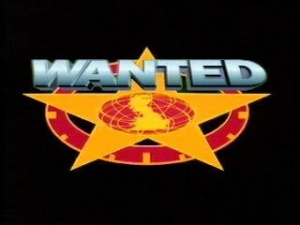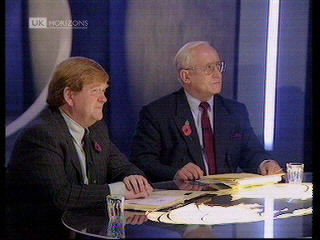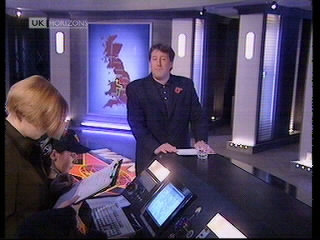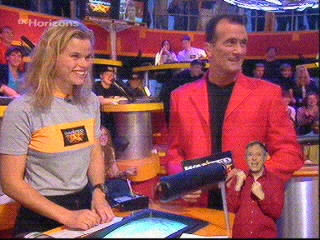Wanted
Contents |
Host
Richard Littlejohn (1996)
Ray Cokes (1997)
Co-hosts
Communications coordinator: Tanya (1996)
Voiceover:
Patrick Allen (1996)
Magenta Devine (1997)
Studio experts: Oleg Gordievsky and John O'Connor (1996)
Broadcast
Hewland International for Channel 4, 30 October 1996 to 22 June 1997 (16 episodes in 2 series)
Synopsis
Shows like Wanted only turn up once in a while, and this one made its debut on Wednesday 30 October 1996, broadcast live for a full hour over 8 weeks.
The Cast
Teams of two members of the public (a.k.a. the Runners) aim to roam the British Isles avoiding being caught by two pursuers (their Trackers). One Tracker actually follows the Runners around the country, while the other stays back at the Wanted Organisation headquarters in London to co-ordinate the hunt. While the Trackers have helicopters and jeeps at their disposal, the Runners are forced to use public transport (buses, trains, taxis and planes) only.
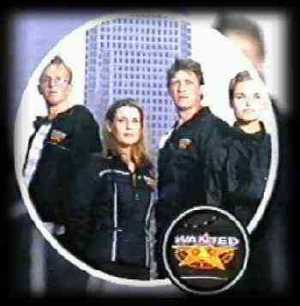 Four of the trackers from the show - Paul Denchfield, Victoria Fay, Matthew Randall and Sarah Odell.
Four of the trackers from the show - Paul Denchfield, Victoria Fay, Matthew Randall and Sarah Odell.The show was essentially in two parts - the daily tasks and the live show itself.
The Daily Tasks
If you're on the run, you'd naturally want to do things: (a) Hide, and (b) Stay in the same place. Unfortunately, there were two very clever rules which prevented this.
Firstly, the Runners have to perform a task (often quite silly) which forces them to break cover once a day. The Trackers know what this task is (e.g. "Have an ice skating lesson for 15 minutes"), but don't know exactly where they're going to do it. Instead, they have to use cunning, guile and good old-fashioned begging in order to extract information from members of the public who might know where they are. For every day that the Runners perform their task without being filmed by their Tracker, they earn £1000.
Secondly, the Runners had to keep on the move. The UK is divided up into a grid of 10 km x 10 km squares, and every day the Runners must move at least one square. Once a team has left a square, they can never go back into it again. A big map showed the team's movement day by day, square by square.
The Live Show
On day 7, before the live show went on air, the Runners had to nominate a public telephone box of their choice within the 10km square in which they had ended up. For the one-hour duration of the programme, they had to stay in that call box and remain in contact with Wanted HQ by a video and phone link during the hour of the live show. If the Tracker could find the correct call box and open the door before the live programme ended, the Runners lost any money they had won during the week and they were eliminated.
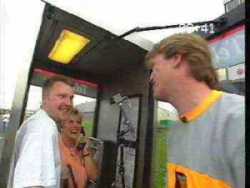 Gotcha! Tracker Matthew Randall finds the right phonebox to deny these two contestants the prize money for that week.
Gotcha! Tracker Matthew Randall finds the right phonebox to deny these two contestants the prize money for that week.Each live show consisted of a brief introduction to the three teams of Runners and their Trackers. There was also a video sequence showing an outline of the rules. Then, team by team, a 10-minute video diary of each teams' progress over the past seven days was shown, demonstrating whether the teams had completed their daily tasks without getting "caught". Interspersed with the pre-recorded tapes we were updated as to how the live hunt was going, and the last few minutes of the show concentrated on the Trackers attempting to find their Runners in their chosen telephone box.
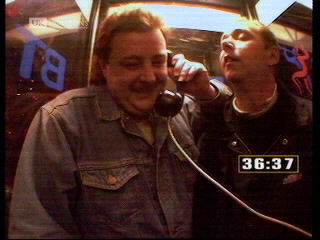 Two contestants trying to solve the Noel Edmonds Number Cruncher.
Two contestants trying to solve the Noel Edmonds Number Cruncher.Although the main purpose of the live show was the chase in progress, the main fun came from the video diaries of the contestants doing their daily challenges, which were often hilarious. In the first week, the teams had to "Visit a castle and get a guided tour", "Visit football stadiums and talk to staff members" and "Shake hands of town mayors". Later tasks included "Spend 15 minutes on an ice rink", "Visit cathedrals and talk to members of the clergy" and "Drive a different brand of new car worth over £50,000".
The Public
Wanted went all-out to make it interactive. This was largely successful, and had one of the best supported web sites during its run. In addition, members of the public could phone in during the week and the live show itself to tip-off the Trackers as to where the Runners were. However, some of the tip-offs were hoaxes. The Tracker in the studio had to decide which lead to follow up, which he did by getting his partner on the ground to visit those phone boxes.
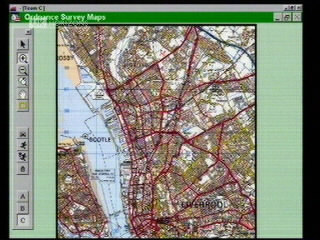 Going in for the kill - computerized map used on the show, displaying the whereabouts of the tracker and the suspected location of the correct phone box.
Going in for the kill - computerized map used on the show, displaying the whereabouts of the tracker and the suspected location of the correct phone box.The Experts
In series 1, Oleg Gordievsky, a former KGB double agent, and John O'Connor, a former head of the Flying Squad, provided comments during the show - much like the in-between commentary you get to fill in the time between frames in a snooker match. They were the resident experts, and they took it seriously. This angle was dropped in series 2, the emphasis being on the witty badinage between the presenter and the Trackers in the studio.
The Hosts
The host of series 1, Richard Littlejohn, had no prior game show experience, and indeed is a stout Londoner with only talk show credentials. However, they picked the right man for the job. He kept the show moving along at a high rate, knew what he was doing, and was just funny enough when appropriate. However, he was a bit too abrasive, perhaps, not showing sympathy or empathy for the contestants. At one point, he described a team as "bottling out", "throwing in the towel" and painting them as cowards.
As part of the "lightening up" process to make the second series less sinister than the first, MTV's Ray Cokes was drafted in. He succeeded in introducing more fun, although it's probably true to say that he didn't handle the live aspect quite as well as Littlejohn. In particular, at the end of the show he'd always try to say "The show may have finished, but the game still goes on"... but he'd always muck that line up!
 Ray Cokes - series 2 host
Ray Cokes - series 2 hostWhat went wrong?
Although the format was miles more imaginative than anything we'd seen for ages, there were some leaks in the hull which, ultimately, sank the show.
Many people questioned the phone box game used for the live show. Somehow, it didn't seem fair that Runners zoomed around the country, doing tasks for the week, but the only way they could win the money was by forcing themselves to stay in the same place for one hour, just hoping that the Trackers don't pick the right telephone box. Granted, making connections and getting hoax identifications sent in is part of the fun, but the two things don't seem to have too much of a link. It's almost like two different game shows, and the hiding-and- hoping-not-to-get-caught one doesn't really require too much skill. In addition, it's hard to motivate the public to ring in and snitch on the Runners, because you'd think the public would want the Runners to win, right? This was soon realised, and (in series 2) a £1000 bounty was offered for information leading to the discovery of the Runners. This helped, but many people thought this unfair.
Series 1 was also strongly based on fear. The Runners squirmed in their phone boxes uncomfortably for the hour - there's nothing they can do about the arrival or otherwise of their Tracker, and they've wasted a hard week of their life (in terms of reward) if they get caught. Plus, for the full week they've been on a knife-edge trying to keep out of the way of their tracker. In fact, one of the first three teams actually threw in the towel before the first live show because they became dangerously paranoid, getting little sleep and even falling into bad health about it. The show deliberately set out to be a cross between Treasure Hunt and the film The Running Man, but whether this is desirable or not is a whole different ball game.
At this point it's instructive to compare the show with Interceptor. The Interceptor in that show was a tremendous comic villain, planning, gloating and scheming in the most over-the-top manner. It was hilarious, and really made the show. There is humour in Wanted, but the trackers are real people, not comic book creations. It's hard to pick a side to support in Wanted. There's no definite feel of good-versus-evil in it. The show would be made easier to watch if at least one of the trackers was designed to be loathed. It could make the show funnier, too.
The final question mark was the show's staying power. The rules, whilst ultimately appearing as simple as Hide and Seek, were rather contorted and had some clear flaws (including the Trackers being told where the Runners had stayed the previous night). Also, many people expected that the telephone box section of the game would get repetitive and (perhaps as too much of a knee-jerk reaction) the game was changed at the start of series 2. All sorts of zany stunts were introduced where the contestants would be cajoled into doing something that gave more information about their location away in return for a £1000 bonus. It just didn't work, and by programme 3 the idea was sensibly binned.
The show had definite cult hit potential, and was ideal for Channel Four. Unfortunately, the show cost a fortune and no TV channel, no matter how big, can afford to spend millions on a show just to cater for a cult. After series 2, the show was put to bed.
The future
The story doesn't end there, however. Bunim Murray Productions produced a US pilot show for the ABC network, spending $2 million in the process and, although they decided not to progress to broadcast, other countries have produced their own full series of the programme.
Key moments
Tracker Paul Denchfield betting his eyebrows on the outcome of a particular programme at the end of series 2.
Catchphrases
"The show may have ended but the game still goes on."
Inventor
The series was credited to a pseudonym called Greg Forrest.
Trivia
Wanted won a Silver Rose of Montreux in 1997.
The show was almost briefly revived to be played by celebrities for 2001's Comic Relief under the title Trackers, but they went for Celebrity Big Brother instead.
One of the trackers, Sarah Odell, went on to take part in the first series of Survivor.
The legendary William G. Stewart was co-producer (with Jane Hewland) on the first series. For the second series, someone called Ian Stewart took over - some relation? We don't know.
The technology of the day, or rather its size, would often cause problems for those tasked with getting the live video links from the telephone boxes up and running, and fed back to the studio. In order to do this, a large satellite truck was needed within a comparatively short cable run of the phone box. However the satellite truck would need to be fairly inconspicuous, as not to give the game away, and reveal the runner's location. When a team decided to play in a large town or city, it was quite easy, as there were plenty of buildings and other structures to hide it behind. However when the runners decided to play in a remote phone box in the middle of the countryside, it would cause a major headache, as a location would need to be found near to the box, but due to it being a rural area, there would often be little more than a hedgerow and a few sheep to hide the large satellite truck behind.
Web links
See also
Original programme launch press release
Official rules for runners
